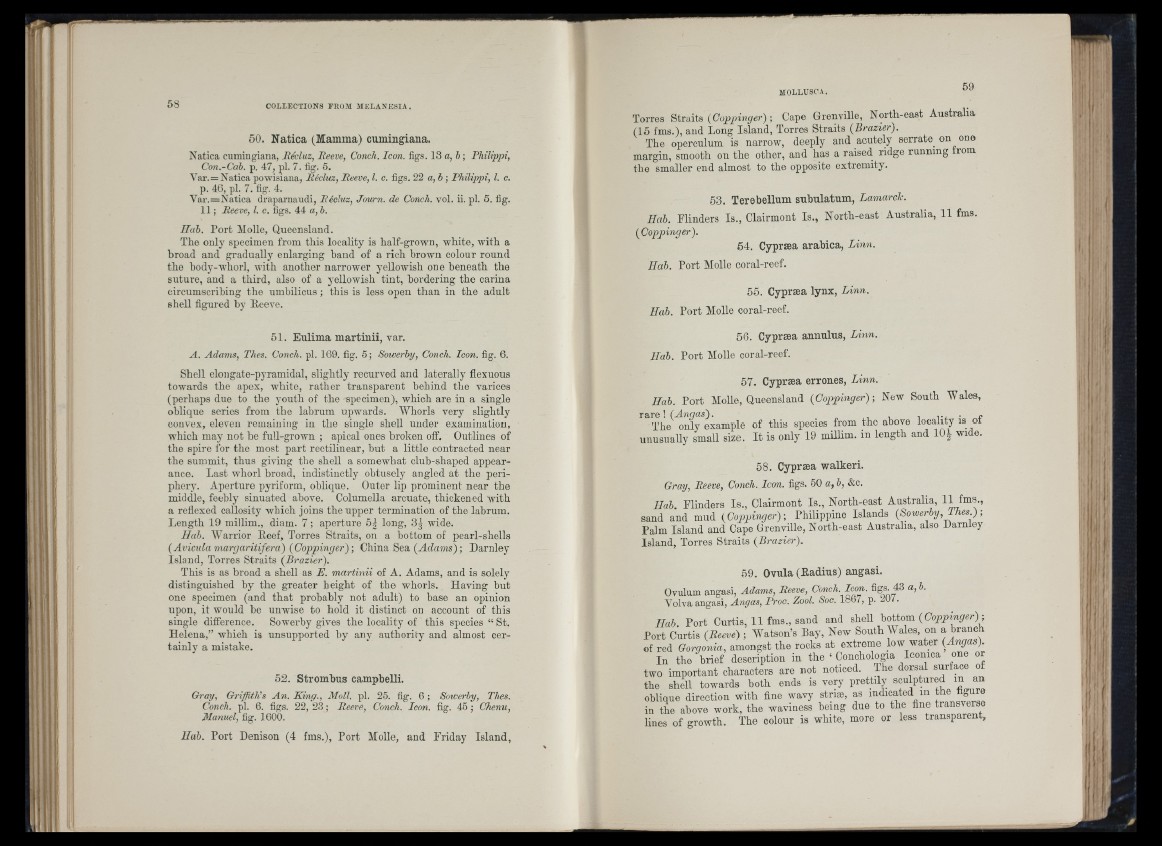
.. 1
\ f
I*
I * I
J ■ I |H
H
¿: ' \
50. Natica (Mamina) cumingiana.
Natica cumingiana, Jtecluz, Reeve, Conch. Icon. figs. 13 «, 5 ; Philippi,
Con.-Cab. p. 47, pi. 7. fig. 5.
A'ar. = Natica powisiana, Recluz, Reeve, I. c. figs. 22 a, b; Philippi, I. c.
p. 46, pi. 7. fig. 4.
Var.=Natica draparnaudi, Pecluz, Journ. de Conch, vol. ii. pi. 5. fig.
11; Ree ve, I. c. figs. 44 a, b.
Ilab. Port Molle, Queensland.
The only specimen from this locality is half-grown, white, ivith a
broad and gradually enlarging hand of a rich brown colour round
the body-whorl, with another narrower yellowish one beneath the
suture, and a third, also of a yellowish tin t, bordering the carina
circumscribing the umbilicus ; this is less open than in the adult
shell figured by Reeve.
51. Eulima martinii, var.
A. Adams, Thes. Conch, pi. 169. fig. 5; Sowerby, Conch. Icon. fig. 6.
Shell elongate-pyramidal, slightly recurved and laterally flexuous
towards the apex, white, rather transparent behind the varices
(perhaps due to the youth of the specimen), which are in a single
oblique series from the labrum upwards. AA^horls very slightly
convex, eleven remaining in the single shell under examination,
which may not he full-grown ; apical ones broken off. Outlines of
the spire for tho most part rectilinear, but a little contracted near
the summit, thus giving the shell a somewhat club-shaped appearance.
Last whorl broad, indistinctly obtusely angled at the periphery.
Aperture pyriform, oblique. Outer lip prominent near the
middle, feebly sinuated above. Columella arcuate, thickened with
a reflexed callosity which joins the upper termination of the lahrum.
Length 19 millim., diam. 7 ; aperture 5 | long, 3g wide.
Hah. Warrior Reef, Torres Straits, on a bottom of pearl-shells
{Avicula margaritifera) (Coppinger); China Sea (Adams); Darnley
Island, Torres Straits (Brazier).
This is as broad a shell as E. martinii of A. Adams, and is solely
distinguished by the greater height of the whorls. Having but
one specimen (and th a t probably not adult) to base an opinion
upon, it would be unwise to hold it distinct on account of this
single difference. Sowerhy gives the locality of this species “ St.
Helena,” which is unsupported by any authority and almost certainly
a mistake.
52. Strombus campheUi.
Gray, GriffitKs An. King., Moll. pi. 25. fig. 6 ; Sowerby, Thes.
Conch, pi. 6. figs. 22, 2.3 ; Reeve, Conch. Icon, fig, 45 ; Chenu,
Manuel, fig. 1600.
Hab. Port Denison (4 fms.), Port Molle, and Friday Island,
59
Torres SiivAis, (Copqnnger); Cape Grenville, North-east Australia
(15 fms.), and Long Island, Torres Straits (Bi'azier).
The operculum is narrow, deeply and acutely serrate on one
margin, smooth on the other, and has a raised, ridge running rom
the smaller end almost to the opposite extremity.
53. Terebellum subulatum, Lamardc.
Hah. Flinders Is., Clairmont Is., North-east Australia, 11 fms.
( Coppinger).
54. Cypræa arabica, Linn.
Hab. Port Molle coral-reef.
55. Cypræa lynx, Linn.
Hah. Port Molle coral-reef.
56. Cypræa auuulus, Linn.
Hah. Port Molle coral-reef.
57. Cypræa errones, Linn.
Hah. Port Molle, Queensland (Coppinger) ; New South Wales,
rare ! (Anyas). »
The only example of this species from the above locality is of
unusually small size. I t is only 19 millim. in length and 1 0 | wide.
58. Cypræa walkeri.
Gray, Reeve, Conch. Icon. figs. 50 a, b, &c.
Hah. Flinders Is., Clairmont Is., North-east Australia, l l jm s
sand and mud (Coppinger); Philippine Islands (S o w e r h y ,^ e s ) ;
Palm Island and Cape Grenville, North-east Australia, also Darnley
Island, Torres Straits (Brazier).
59. Ovula (Radius) angasi.
Ovulum angasi, Adams, Beeve, Çonch. Icon. figs. 43 a, h.
Volva angasi, Angas, Proc. Zool. Soc. 1867, p. 20/.
Hah. Port C u r t i s , 11 fms., sand and shell T o o A o v a (Coppinger) ;
Port Curtis (Reeve) ; AVatson’s Bay, New South Wales, on a branch
of red Gorgonia, amongst the rocks at extreme low water (^Angas).
In the brief description in the ‘ Conchologia Iconica one or
two important characters are not noticed. The dorsal surface of
the Bhil towards both ends is very prettily sculptured m an
oblique direction with fine wavy striæ, as indicated in the hgure
in the above work, the waviness being due to the fine transverse
lines of growth. The colour is white, more or less transparent.
1 ; \
I.